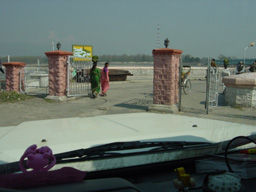
Crossing the border
 Crossing the border |
Now we head for the border checkpoint going into Nepal. At this small customs station people with bicycles, rickshaws, cows, oxen and goats cross the border and fortunately the standard bureaucracy hasn´t reached here yet. Our entry permit is promptly stamped into our pass and surprisingly our carnet documents are just as quickly cleared. This procedure takes place in a small room with three wooden desks and with a bed in the corner where one of the officers is taking a rest from his hard job! Nobody is interested in checking or searching our land cruiser. We are very glad about this since the motor identification number is in a spot that is only readable with flashlight and mirror. When the motor is hot, you could definitely burn your fingers which doesn´t exactly make a customs official happy. After a short check over by the police all of our Indian money is changed into Nepalese rupees at a "bank hut". We ask for an exchange receipt, which is required for visa extensions for instance, but are given an uncomprehending shake of the head in return.
And we´re off to Bardia National Park on the East-West Highway. We haven´t gone 50 kilometers when a very unfriendly policeman stops our land cruiser. The police search our vehicle and a clarifying talk with one of the officers ends the spectacle. Now we understand what it means to travel in a country where a state of national emergency has been declared. Ever since the Maoist guerillas have attacked several police stations leaving 300 people dead, security in Nepal has been very nervous and very rigorous.
Shortly before Bardia National Park another military control awaits us. They don't want to let us pass since the road will be closed for security reasons at 5 p.m. It takes a lot of explaining before they allow us to continue our journey - with an official pass. We really do not want to spend the night on the road. Now we understand why the road has been so wonderfully empty.
We must hurry since it is already getting dark. Our first obstacle on the gravel road to the national park is an old wooden bridge, which would surely fall apart under the weight of our land cruiser. We decide to drive through the river and go up the steep embankment. The villagers are quite amazed that we succeed in arriving safely on the other side. An old tractor is parked there ready to rescue vehicles - a "side job" for the locals.
At 6 p.m. we reach the bush camp. We are the only guests around, because the guerilla attacks tend to frighten off the tourists. In a small clay hut with a fuel lamp we finally lay down under the mosquito net being very tired indeed. After all, a 7 p.m. curfew is imposed on all inhabitants.
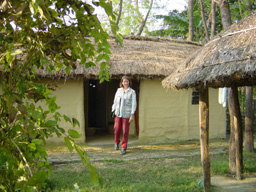 Busch camp |
 Thakurdwara |
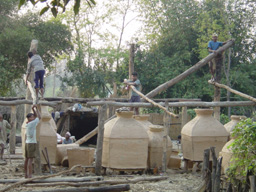 Village life |
The military camp seems out of place in the midst of this harmonious village community. The soldiers barricade themselves behind sandbags and barbed wire to protect themselves against the nightly attacks from the Maoist guerillas. Machine guns are aimed at the tourist huts. As a precaution the owner has housed some family members of the soldiers in the empty huts -virtually as a kind of life insurance. We are glad to be lodged a little farther off.
The park's area stretches over approximately 1,000 square kilometers and consists of either jungle or grassland. We hope to see one of the famous Royal Bengal tigers living in the wild. Not an easy undertaking, since each tiger has a hunting territory of about 60 square kilometers through which he wanders regularly. On the first day we hike through the park from sunrise till sundown led by our Tharu guide. We see numerous animals, but no tiger. Many fresh footprints and the typical tree marks tell us that at least we are in the right area. In the middle of the low grassland we are no longer sure if we really want to meet a tiger face to face at this spot. Our guide is at least armed with a bamboo stick.
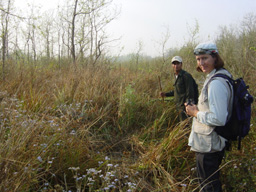 Where´s the tiger? |
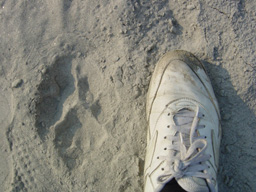 Tiger footprints |
On the second day we try our luck by driving 50 kilometers throughout the park, but this too is hopeless. Tigers have excellent ears and disappear quickly in the undergrowth or the grass. The next day we change our tactics and find a fixed observation point in a tree at a wide, almost dry riverbed. We sit here hour after hour waiting in the boiling heat. Once in a while monkeys or other animals sounding their danger signal encourage us. Shortly before sundown the great moment: A large Bengal tiger steps out of the high grass at the embankment and obviously feels completely unobserved. Very slowly it majestically crosses through the knee-deep water to the other side of the river and soundlessly disappears. Unfortunately we have no picture for the website because yesterday our digital camera broke down forever.
We are enriched by this wonderful experience in nature and leave Bardia heading east for Royal Chitwan National Park 350 kilometers away. Here we have a totally different experience. Everything is completely touristy. The village at the entrance no longer has its traditional structure and concrete houses have replaced many of the original clay huts. The climax of this visual pollution is a multi-story hotel built next to the riverbank. There are many restaurants, lodges and souvenir shops. We liked the Bardia National Park much better. But at least we see a big rhinoceros at sundown that slowly wanders through the grasslands.
A particularly special event is our visit to the state elephant farm. Elephant babies, only a few months old, romp boisterously around and integrate us into their games. On our way back we drive through a river and spontaneously decide to wash our land cruiser. Suddenly there are lots of children around us who all want to help. The car wash quickly results in a water fight - pretty refreshing at 35 degrees Celsius. We are relieved there are no crocodiles in this river as is usual.
In Katmandu we do not have much time to see the attractions of the city and its outskirts. We have a long list of things to do. Andreas sees a dentist who replaces the temporary filling that Ute put in at Corbett National Park. Quite an adventure with nostalgic dental equipment! The broken camera is brought to the Sony service center. This is where we learn that the Sony worldwide guarantee is not worth the paper that it is printed on. Sony's central service center in Singapore even confirmed this in writing. To be able to provide pictures for our web community, we buy a new camera with the surprise that it is 400 euro cheaper than the special sale price in Berlin. We also have to go to various embassies to settle our visas and restock our provisions. Thanks to the professional support of the PROVIDE Auslandslogistikteam (foreign logistics team) of Deutsche Telekom our irreparable tire is replaced by a new one and flown into Katmandu. Tubeless tires are rare in India and Nepal.
And lastly our land cruiser is wrapped in a huge tarp just like a Christo work of art because it will take at least three weeks of hiking to get to the icy altitude of the Everest Base Camp. We start in Jiri, which is 188 kilometers and twelve (!) bus hours away from Katmandu. To have enough time to acclimatize, we don't fly directly into the mountains. The route we take represents the historical path taken by Edmund Hillary and Tenzing Norgay to the peak of Mount Everest. We follow the grandson of Tenzing who started yesterday following in the footsteps of his grandfather. We avoid booking through a professional trekking agent offering the usual "worry-free mountain package" and carry our equipment ourselves. By the way, the complicated permit procedure for these tours no longer exists. All you need is an entrance ticket for the Everest National Park. We hope we can report in about three weeks online about our experiences when we safely return and we set out in good moods into the icy altitude.
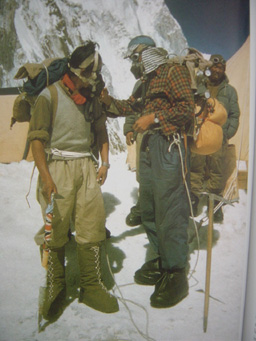 Hillary und Tenzing (1953) |
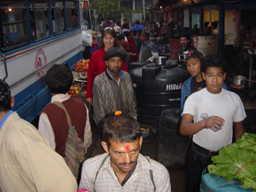 Chaos at the bus station |
Fortunately there wasn't too much cash in the wallet and we could quickly report the credit card theft. Later we hear of many similar thefts that happen to foreign trekking tourists in the bus to Jiri. Backpacks are opened or completely disappear when passengers go through the usual "Maoist check" by the army in front of the bus. We are lucky and arrive after nine long hours to Jiri with all of our equipment.
We stay the night in a very pleasant Sherpa lodge paying only 100 rupees (that´s about 1.30 euro). The price of an overnight stay will decrease to 10 rupees soon after. Remembering the day rate of a professional trekking agent being up to $100 US a day, we are glad that we organized our tour ourselves.
 Stupas aon the road |
The next day we depart from Jiri for Namche Bazaar, a Sherpa settlement at a 3,340-meter altitude. For eight days we hike the beautiful foothills of the Himalayas at heights of 1,600 to 3,500 meters - continually climbing and descending and climbing again. Particularly impressive are the rhododendron woods in bloom and the traditional Sherpa settlements. The icy giants can be seen from every vantage point in the background.
 Still green landsape |
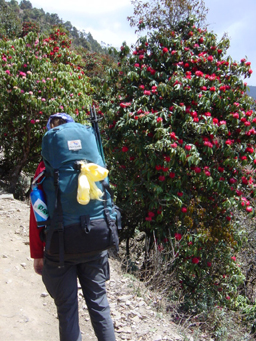 Rhododendron bloom |
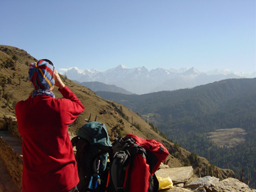 Out target is close |
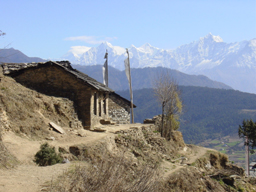 Lodge with view |
We have no trouble finding accommodations and spend the evening with the entire Sherpa family at the open fireplace. The Maoist guerilla attacks are their number one topic.
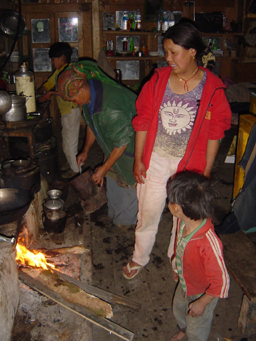 Large kitchen/living room |
Everywhere you see their influence: Right on the first day we see a large red flag on arrival at the town of Shivalaya. It marks where guerilla territory begins and the authority of the Nepalese government ends. All police sentries had been expelled. The yak cheese factory had to close because the Maoists thought of it as a self-service shop with free goods. Every week "donations" are collected from the locals by force of arms. If they don´t pay, they are shot. Many lodge owners have already fled to Katmandu or abroad. Capturing the people's mood: Civil war is imminent. In an open letter to the people last week, the Maoist leaders declared that tourists are not the targets of their actions. But you better be careful that you don't accidentally get in the way of one of their gun battles with the army.
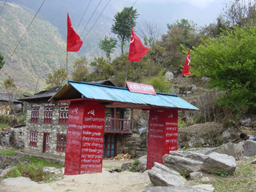 Maoist guerilla influences are everywhere |
We are relieved when we reach Namche Bazaar without having to "donate" anything to the guerillas. Here we will need two days to get used to the altitude. Many trekkers fly directly to Lukla and set out for Namche the same day. Frequently they don't have time to acclimatize and as a result they suffer from altitude sickness. Our destinations in the next weeks are Kala Pattar (5,540 meters), the Everest Base Camp (5,364 meters) and Gokyo Peak (5,357 meters).
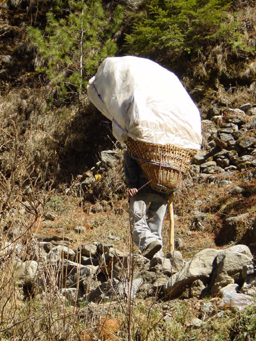 Porter |
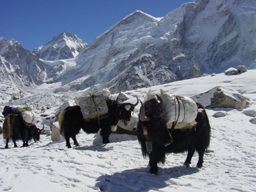 Yakkaravane |
Before our ascendant we once again lay each piece of equipment on our so-called Golden Scale. In high altitudes each gram of weight that you can spare counts. After a critical check we reduce our backpacks of about 12 kilos each and deposit the objects we´re leaving behind at our accommodations.
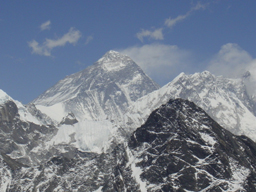 Destination Everest |
The trail leads to the famous Tengboche Monastery (3,771 meters), where we were surprised with new fallen snow the next morning. It is lots of fun watching the young monks ski with provisional pieces of wood.
 Tengpoche Monastery |
 Holer skier |
In the meantime, the setting had transformed itself into a high alpine landscape. The timberline lay at about 4,000 meters, the trails are very dusty and the air very dry. We are excited about the immediately adjacent giant mountains to the right and left of us with their walls of ice and glaciers.
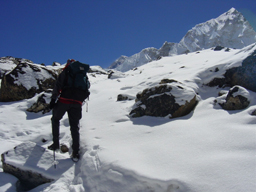 Alpine landscape 1 |
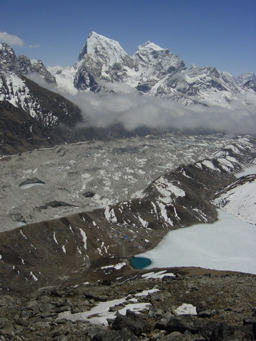 Alpine landscape 2 |
We take it very slow to avoid the possibility of altitude sickness even though our condition would have allowed for a faster walking pace. To prevent dehydration we each drink at least three liters a day. Sometimes we just can´t stand seeing our usual "hot lemon" drink. Coffee, tea, carbonated drinks and beer are not allowed at these altitudes. On the way, we´re amazed at the tight time schedules and how fast other hikers (usually in groups) are in transit. We will meet many of them later with acute health problems. In this case only a quick descent will help, as long as one can still walk. If not, the transport can only proceed with porters, on yaks or by helicopter into the valley. Even the dry, dusty air and the cold drafty sleeping places earn our tribute. During one of our acclimatizing days in Perich (4,280 meters), Ute´s bronchitis gets worse and she comes down with a high fever. A doctor from the Himalayan Rescue Association gives her a strong dose of antibiotics and after four days of "sleeping-bag rest" we are able to proceed slowly to Dughla (4,620 meters), and a day later to Gorak Shep (5,170 meters). With a temperature of minus 25 degrees Celsius it is very uncomfortable indeed - with no heating in sight.
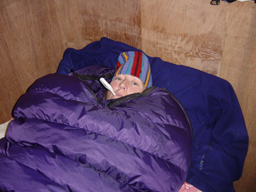 "Sleeping-bag rest" |
On the way to the Everest Base Camp we are able to make acquaintance with a lot of people at the Sherpa lodges during talks in the evening. We get to know Guy Cotter, the successor and friend of Rob Hall who met with a tragic accident on Everest in 1996, and have interesting discussions about the advantages and disadvantages of commercial expeditions and over the motivation that drives people to want to climb Everest for large amounts of money. We trek through snowfall in a continual zigzag up the lateral moraine of the Khumbu glacier to the Everest Base Camp (5,364 meters), where we again meet the whole expedition team of Adventure Consultants and leave with an immediate impression of what everyday life in an expedition feels like. Currently, 15 expeditions are on the way to Lhotse and Everest. Up-to-date information about the comings and goings can be seen on www.everestnews.com.
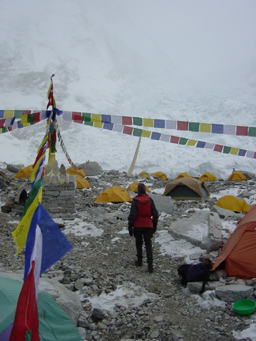 Everest Base Camp 1 |
 Everest Base Camp 2 |
Besides the Pumori Base Camp, where an American expedition is in the state of preparation at the time, we climb the "Everest lookout" of Kala Pattar, or to be more exact, a side flank of Pumori (5,680 meters). From here you have a beautiful panorama of the Everest Peak (8,848 meters), which, however, is excelled by the view from Gokyo Peak (5,357 meters). In order to get there we have to cross over the glaciered Cho La (Pass) at 5,370 meters, a very demanding but also the most beautiful part of the tour. Parts of the way call for real rock climbing.
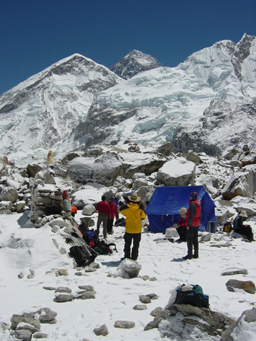 Pumori Base Camp |
 The view of Everest from Kala Patthar |
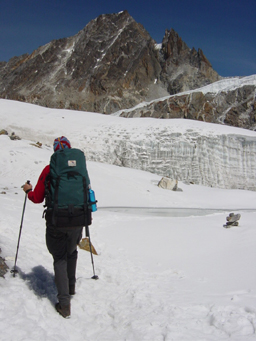 Crossing Cho La |
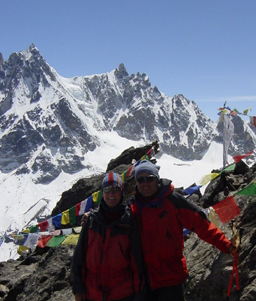 Gokyo Peak |
After all those wonderful experiences we take two very long days to trek over Namche Bazaar to Lukla (2,842 meters), a place where a small airstrip (for propeller planes like aircraft carriers) was built. During our descent we experience an "oxygen rush", which is extremely energizing. We are lucky that there are no interruptions of plane schedules due to rock-hiding clouds that day. After a short 50-minute flight we again reach Katmandu.
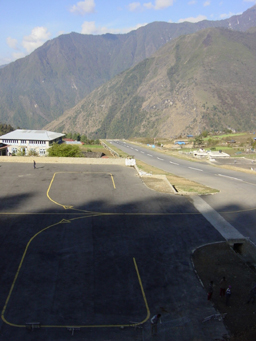 Lukla Mountain airport |
Maoist rebels call for a national general strike for initially five days. Civil services come just about to a complete standstill. For fear of encroachments everyone takes part in the strike. Nation-wide terrorist acts on the civil infrastructure and even on Red Cross vehicles increase. Recently, the Base Camp of the Makalu Expedition was robbed where money and equipment was extorted from the participants. The air in Katmandu is heavy with lead and explosives. We decide to leave the land cruiser under the "Christo-plane" and to take our bearings.
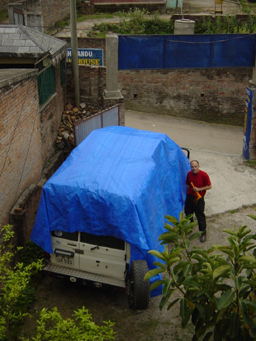 Packaging à la Christo |
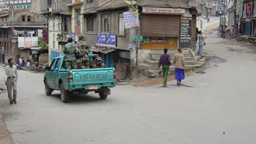 State of emergency |
Simultaneously, we are intensively working out our trip to Tibet to get together the necessary travel documents.
Our long list of things that we have to settle is slowly getting shorter. A new tire and some spare parts are picked up at a moving company and the land cruiser is thoroughly checked at a Toyota workshop.
 Cleaning the motor |
Oh heavens! The bumper at the left in the back didn´t make it through the demanding street conditions and is dented. This was a special bumper for particularly rough conditions in Australia so naturally a replacement in Nepal is not even thinkable. The following is an indication of Germany reliability. One email to Martin Többin from the Toyota dealership of the same name in Hanover and a new bumper as a goodwill gesture is ready to be delivered. Over the Internet, through the work of the DAV Summit Club, a friendly mate is found that will transport the part within the week to Katmandu.
We had less fortunate experience with our bank and the Visa card organization. Initially, according to the bank, it´s no problem to replace a Visa card that was stolen at the bus station at Katmandu. It would however take four weeks. Immediately we found out what it means to trust the nice advertising slogans from Visa. Sending the card to Nepal was declined for lack of security and high cost. We were told to telephone a number in the USA where we were told to try our luck elsewhere. It´s too bad that Visa and the VAG Bank seemingly have restricted their customer services to Germany only. Woe to those who find themselves completely penniless after having their card stolen in a foreign country and have to beg for help from completely uncooperative service personnel.
We want to get to know the cultural and historical side in this our second time in Katmandu. The Katmandu valley where today about 1.5 million people live bears witness to great kings, palaces, art and culture. We visit the Durbar Square in Katmandu and in Bhaktapur where the number of temples and other historical architecture just about overwhelms us. Bhaktapur has been rebuilt by diverse foreign restoration projects to that what it is today. This city at the gate of Katmandu is very clean, makes a peaceful impression and invites one to wander through the city. From our own experience we recommend you stay for a night in order to experience the early morning atmosphere and the goings on of the local people.
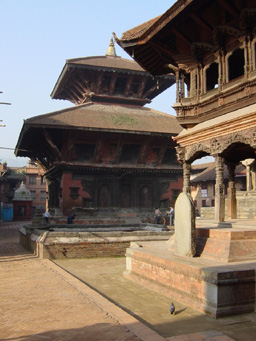 Bhaktapur 1 |
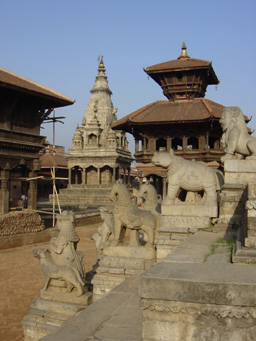 Bhaktapur 2 |
We try to see the positive side of the strike and use the vehicle-free time for a bicycle tour. Pashupatinath, one of the most important Hindu temples in Nepal, is our goal. At this location the public burning of the dead take place on the riverbanks of the holy Bagmati. The dead are laid out on a heap of wood and burned in sympathy of the family. The rest of the corpse is left to the river.
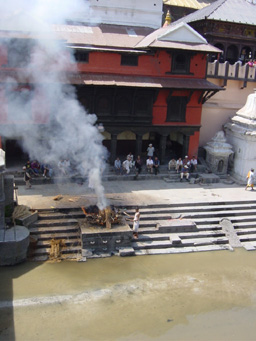 A burning of the dead |
Next we visit the great Swayambhunath-Stupa, a Buddhist temple on the green hills at Katmandu.
 Swayambhunath Stupa |
We decide to make our wait a bit more pleasant and drive the 200 kilometers westward to Pokhara where we set up camp on a lake with a glorious view of the surrounding mountains. It is here that we meet other people traveling in their own vehicles for the first time. We´ve longed for the camping life for a long time now, for our comfortable roof-top tent and our own cooking.
 Camping on the lake |
Pokhara is a good base for great treks in the Annapurna area. And we will undertake many of our own treks because we feel the “itch” already. The beginning of the monsoon graces us almost daily with hefty rainstorms, lightning and temperatures of over 30 degrees Celsius. Not exactly ideal conditions for longer treks so that we already have the essentially drier Tibet on our minds.
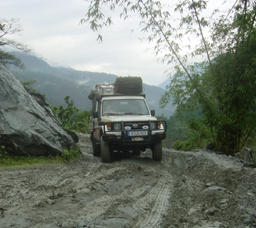 Off road to Beni |
We start our short trek to Mustang in the north. In the old days the legendary salt caravans traveled from Tibet to Nepal and then onward to India on this trail. On our first day's trip we are guided through lush green mountain scenery with terraced fields and little villages.
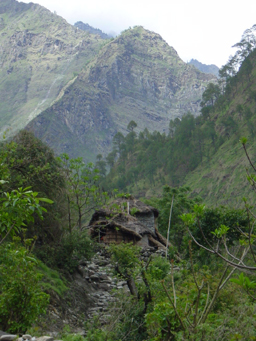 Mountain landscape |
We have to share the trail with countless mule trains, a difficult undertaking in narrow and steep places. The mules really don´t have a feeling for how wide they are with their bulky burdens and now and again we bang into each other. One time a mule almost falls into the canyon.
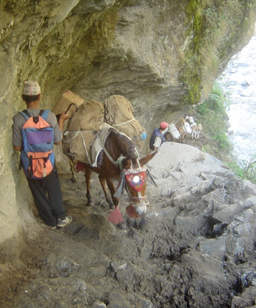 Mule train |
Our first goal is Tatapani (hot water). This settlement is famous for its hot springs that are dammed up in small pools at the riverbanks. Our bath does us good and we enjoy the view of the surrounding mountains.
 Bathing in the hot pool |
The next day we continue through the river valley of Kali Gandaki, the deepest canyon in the world, to Gaza. Still the bottom of the valley proceeds through the canyon at an altitude of 1,500 meters and is bordered by two 8,000-meter high mountains. The real dimensions of the canyon can only be realized by hiking through.
 Entering the canyon |
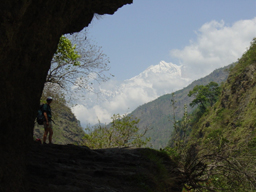 A view of the Nilgiri (6839 m) |
Because we have to prepare for Tibet in Katmandu we decide with heavy hearts to turn back the following day.
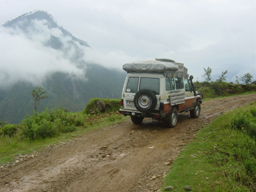 Nepal during the monsoon |
Curiosity about our unusual travels swelled to raging interest in Nepal. On Monday a small press conference with twelve Nepalese journalists took place in the Tibet Guest House. Our travel schedule, our experiences in Nepal and naturally our land cruiser were in the forefront of the discussion.
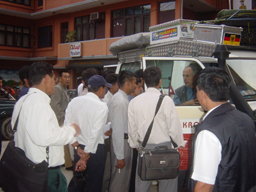 The interested press |
The positive press resonance is very surprising. By now five Nepalese newspapers have reported about us and more will follow.
 Press release 1 |
 Press release 2 |
 Kathmandu Post |
Nepal will stay in our minds as images of terraced fields going up the snow-covered 8,000 kilometer high Himalayas, or of the picturesque mountain villages or the jungle in Terai with its unique wild life. We like to think back on the evenings in family homes and the many conversations we had with the Nepalese. Their unobtrusive friendly openness always inspired us. But as soon as the modern western world makes its advance, the people lay aside their traditions and many of their values and adapt to the "western way of life". You can´t really blame these people for their needs. And therefore, tourists don´t often meet the hoped for "ethnological Disneyland" with the motto "poor but happy".
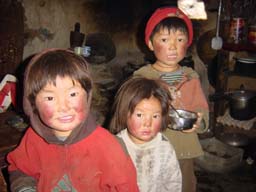 Sherpa children |
Nepal is one of the poorest countries of the world and behind the idyllic facade of a kingdom that has been making its unsteady path towards parliamentary democracy since 1990 hides political and ethnic tension. Over 20 ethnic groups live in Nepal, where Hinduism and Buddhism influence daily life as much as the caste system.
Mass exodus into the capital city of Katmandu brings massive problems. Although the city has developed enormously, the fundamental infrastructures of waste removal, water supply and roads are hopelessly behind the times. Ecologically the city is collapsing and projects like measuring the air quality are practically ridiculous. Everyone knows that the causes are stinking two-stroke engines, ancient diesel buses and fumes from brick and carpet factories. Currently it´s being discussed if the garbage should continue to be dumped at the riverbank or if building an expensive new garbage dump is worth the trouble. But it is particularly in the “rich city” of Katmandu where private schools, banks and hospitals as well as all possible luxury goods make the difference between rich and poor in the rest of the country very obvious. Above all the upper class of Nepal fears the influence of the Maoist Maobadi guerrillas, who want to rid Nepal of its, according to them, corrupt system and redistribute the wealth. And in this respect we find their behavior in the last months particularly incomprehensible. Many civil facilities such as the water supply, telephone lines, local public transportation, bridges and even an SOS-Kinderdorf (orphanage) were destroyed and therefore targeting principally the poor. In this respect we discover many contradictions involving political demands and the actual conduct of the Maoists. Often we hear the argument that foreign power wishes to destabilize Nepal in order to heighten their effort of influence. One only hopes that they arrive at a peaceful accord. We have never felt fear or threatened as tourists in Nepal. Even though for all the commotion about the political situation not once has a tourist in Nepal been harmed. Something that can´t be expected in other popular countries of tourism. It would be a grave mistake if tourists would decide not to come to Nepal on account of the difficult situation because the country and its people would lose their main source of income.
We would like to say Sabai Thik Chha - good luck - and wish Nepal inner peace, because in all our conversations with its people this was their greatest hope.
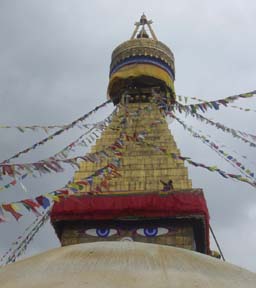 The eyes of Buddha |